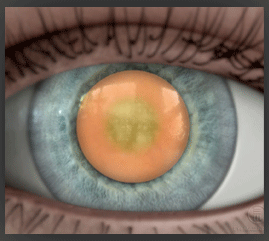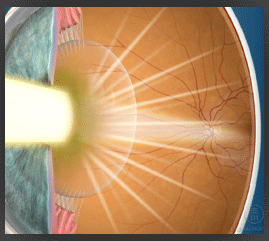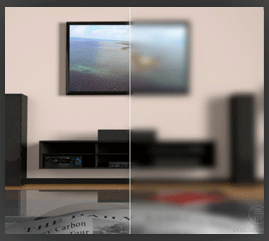Cataracts
Cataracts are the leading cause of blindness worldwide. It is estimated that 40-50 million people throughout the world suffer from blindness. Almost half of these are due to cataracts. Fortunately, today, this is a very treatable condition. In fact, here in the United States alone, over one and a half million cataract surgeries are successfully completed every year.
What exactly is a cataract?


There is a common misconception that a cataract is a "film or growth" over the eye that needs to be scraped away. In reality, it's a simple clouding of the otherwise clear natural lens inside the eye. The eye works much like a camera. The light has to be able to pass through the lens to be clearly focused on the retina at the back of the eye. The natural lens plays a major part of the focusing power and must provide a clean, sharp image. Any cloudiness or distortion in the lens results in a blurred image.
How common are cataracts?
Cataracts are the most common cause of vision loss in adults over the age of 40. Other causes may include certain medications, trauma, and diabetes or other medical conditions. An estimated 20 million patients worldwide are blind as a result of cataracts. Dr. Ahdoot and his team can help diagnose cataracts with an ophthalmological exam and testing. If you are seeking to learn more about this condition, we provide detailed answers to some of the most frequently asked questions.
Is there something I did to cause cataracts?
No. There is no one single cause of cataracts. They don't develop by reading too much or over using your eyes, nor do they develop by sitting too close to the T.V. as a child or by excessive computer work as an adult. In most cases, cataracts cause no harm or damage to the eye. They just blur the vision, making daily tasks such as reading and driving progressively more difficult. Some cataracts, however, are potentially harmful and dangerous if left untreated. This type can only be diagnosed by a detailed ophthalmology examination.
What actually causes cataracts?
The development of cataract changes in the natural lens is multi-factorial with a long list of possible causes. By far, the most common cause of cataracts and blurred vision is the natural aging process of the eye. Even though some children may actually be born with cataracts, most people develop cataracts in their 60's through 80's. However, just about everything has some influence on our vision, including ultraviolet light exposure, genetic predisposition, diseases that you may have had over your lifetime or the medications taken for those diseases and any injury or major trauma to the eye. Since everyone's lifestyle and medical history are so different, it's not uncommon to see cataracts at any age. Sometimes, it's impossible to identify the exact cause, but the treatment is always the same. In most instances, cataracts can be found in both eyes but it is frequently asymmetrical with one eye much worse than the other. Because each person is so different, it is difficult to predict how quickly your cataract may progress. The clouding may proceed at a rapid rate and cause disability and significant blurring in only a few short months. On the other hand, many people know they have cataracts but have no change in their vision for many years.
How do I know if I have cataracts?


Common symptoms include increasing difficulty performing day-to-day tasks such as reading and driving your car, especially at night. Since the cataract is a clouding or darkening of the natural lens in your eye, it's like wearing sunglasses in the house. You need more light just to read normally. Night time becomes especially difficult not only from the low light level but also due to glare. The light that passes through a cataract is scattered and unable to focus. Car lights and street lights create a major source of glare and decreased vision. You might complain of a filmy appearance to your vision and find yourself constantly trying to clean your glasses without success. As your cataract worsens, it also changes your prescription. Frequent changes in your glasses and difficulty improving your vision with new prescriptions are common. A cataract can cause even double or triple images in one eye. Only a complete, dilated exam by your ophthalmologist can correctly diagnose a cataract and evaluate your vision.
The good news is that with modern advances in surgical techniques and treatment, cataract surgery has become one of the most effective and successful procedures known within the medical community today!
The good news is that with modern advances in surgical techniques and treatment, cataract surgery has become one of the most effective and successful procedures known within the medical community today!
When is surgery indicated?
Cataracts never get better; they always remain the same or gradually worsen. There's no medicine, exercise or special vitamins that will cure or prevent cataracts. The only known treatment involves surgical removal. The insurance industry has adopted Medicare guidelines stating that insurance coverage is available for those patients whose vision measures 20/50 or worse. At this level of blurry vision, the Department of Motor Vehicles (DMV) will no longer issue you a license to drive. However, just because you have a cataract, surgery is not required until it bothers you or affects your lifestyle.
Even if your vision is worse than 20/50, surgery is indicated only if a change in your glasses prescription will no longer improve your vision and your daily activities such as reading and driving have become impaired. Cataracts do not have to be "ripe" for surgery to be indicated. That is an older term used in times past for more mature cataracts. Cataract surgery can now be performed whenever the visual needs of the patient require it and only in rare circumstances is cataract surgery considered an emergency. If you can still read, watch TV in comfort and perform daily activities such as cooking, shopping, taking medication and reading street signs at a distance, then surgery may be postponed. Based on your visual needs, you and your ophthalmologist should decide together when the timing is right and when cataract surgery is appropriate.
Even if your vision is worse than 20/50, surgery is indicated only if a change in your glasses prescription will no longer improve your vision and your daily activities such as reading and driving have become impaired. Cataracts do not have to be "ripe" for surgery to be indicated. That is an older term used in times past for more mature cataracts. Cataract surgery can now be performed whenever the visual needs of the patient require it and only in rare circumstances is cataract surgery considered an emergency. If you can still read, watch TV in comfort and perform daily activities such as cooking, shopping, taking medication and reading street signs at a distance, then surgery may be postponed. Based on your visual needs, you and your ophthalmologist should decide together when the timing is right and when cataract surgery is appropriate.
How is cataract surgery performed?
Cataract surgery has evolved over the years into a "no shot, no stitch, no patch" procedure. In most cases, the patient is awake and alert and no longer is a large shot or painful injection required like the Novocain shot given at the dentist's office. Anesthesia is performed simply by using a few topical drops on the eye to be operated. Since the cataract is the clouded natural lens inside the eye, a small self-sealing incision is made.
The incision is so small that no sutures are even required to close it. Because there was no large injection used, no patch or covering is placed over the eye upon completion. Some people feel a slight scratchiness like a lash in their eye the first day but most people feel just fine with no irritation at all -- "No shot, No stitch, No Patch". It can and should be an easy, relaxing yet exciting experience.
The incision is so small that no sutures are even required to close it. Because there was no large injection used, no patch or covering is placed over the eye upon completion. Some people feel a slight scratchiness like a lash in their eye the first day but most people feel just fine with no irritation at all -- "No shot, No stitch, No Patch". It can and should be an easy, relaxing yet exciting experience.
What do I need before surgery?
Once it has been determined that cataract surgery is necessary, you will need a follow up appointment to perform all the required preoperative measurements and scheduling. An A-scan test is performed with ultrasound and a new non-contact laser probe to accurately measure the length of your eye and the curvature of your cornea. These measurements and others are used to calculate the power of the new lens implant that will be used to restore your vision.
Your artificial intraocular lens (IOL) implant options will be discussed with you (e.g. seeing well for far, distance and near with glasses, needing to wear reading glasses only, etc.). Your medical history including all your current mediations and dosages will be noted and discussed. A special date and time for your surgery will be scheduled as well as all of the necessary follow-up visits. In addition, you will be given medical clearance paperwork for your primary care physician to complete stating that you are medically stable to undergo minimally invasive cataract surgery under topical anesthesia with monitored anesthesia care.
Your artificial intraocular lens (IOL) implant options will be discussed with you (e.g. seeing well for far, distance and near with glasses, needing to wear reading glasses only, etc.). Your medical history including all your current mediations and dosages will be noted and discussed. A special date and time for your surgery will be scheduled as well as all of the necessary follow-up visits. In addition, you will be given medical clearance paperwork for your primary care physician to complete stating that you are medically stable to undergo minimally invasive cataract surgery under topical anesthesia with monitored anesthesia care.
What can I expect the day of surgery?
Eye surgery can evoke a lot of nervousness and anxiety about what you might see or feel during the procedure. There's no need to worry. We have caring professionals that will walk you through each step of the way. The surgery takes place at a fully licensed and accredited surgery center or specialty eye hospital. You should plan on being there one and a half to two hours early, but the surgery itself takes approximately 15 minutes. Upon arrival, the nurses will lead you back to our preoperative area where you will comfortably recline. An anesthesiologist will review your medical history and listen to your heart and lungs. He will monitor your blood pressure, heart rate and breathing throughout the procedure.
Before entering the operating room, several topical drops are used to anesthetize your eye and dilate your pupil. When all is ready, you will be led into the operating room where you will need to lay on your back and look up into the operating microscope. Sterile drapes are used to cover your face and a small instrument is used to gently hold your eyelids open. A very small painless self-sealing incision is made at the side of your cornea and the cataract is quickly removed and a small artificial intraocular lens (IOL) implant is inserted back in its place. The new lens implant is calculated specifically for your eye and will provide the most natural vision possible. In fact, everything will be sharper, colors will be more brilliant and the cloudy vision will be gone. You will need to start using your postoperative eye drops and return the following day for your first checkup visit with your surgeon.
Before entering the operating room, several topical drops are used to anesthetize your eye and dilate your pupil. When all is ready, you will be led into the operating room where you will need to lay on your back and look up into the operating microscope. Sterile drapes are used to cover your face and a small instrument is used to gently hold your eyelids open. A very small painless self-sealing incision is made at the side of your cornea and the cataract is quickly removed and a small artificial intraocular lens (IOL) implant is inserted back in its place. The new lens implant is calculated specifically for your eye and will provide the most natural vision possible. In fact, everything will be sharper, colors will be more brilliant and the cloudy vision will be gone. You will need to start using your postoperative eye drops and return the following day for your first checkup visit with your surgeon.
What if I have claustrophobia?
Some people have a very real anxiety about having their face covered or being all wrapped up. It's actually very easy and relaxing with someone right by your side the entire time. An oxygen cannula blows fresh air in your nose and the anesthesiologist can give you a small dose of medication through an I.V., which quickly and easily calms your nerves. Only on rare occasions is it necessary to use general anesthesia and put the patient to sleep. You should find the experience much easier than anticipated.
What is the new lens implant made of?
The new lens is called an "Intraocular Lens" (IOL) and is made of plastic, silicone, acrylic or collamer. Depending on your particular anatomy and visual needs a special power and style are chosen with a specific power calculated for you. These IOLs are folded or rolled up and injected into the eye through the same microscopic small incision. These implants allow the incision to self-seal and rarely require sutures. Be assured that whichever lens implant is used, it was chosen with your safety and best visual results in mind. Click here to learn more about your different IOL implant options.
Is there any blood?
Most cataract surgery is performed using a very small painless microscopic incision through clear cornea where there are no blood vessels; hence there is no blood. Because of this, patients taking aspirin or Coumadin, technically are not required to stop their medication. However, if at all possible, stopping before is preferable. If you have any concerns, speak with your cardiologist or internist. Do not stop any medications without first consulting with them.
When do I get my new glasses?
Since you now have new eyes, your old prescription will be wrong. It will not do any harm to wear your old glasses temporarily, but, if needed, a new prescription will usually be written for you at your four week postoperative visit. If you choose a new Premium IOL, chances are you will not need glasses at all in the majority of situations. Whatever the case may be or IOL you choose, you will love your newfound vision and the freedom it provides.
Do cataracts grow back?
No, this is a once-in-a-life-time procedure. Cataracts do not grow back. However, in some patients, it is possible that the membrane that held the natural lens in place might become hazy or cloudy. In fact, it may appear as though the cataract has returned. This is called "posterior capsule opacification" and results in significant glare, sensitivity to lights, and decreased vision. If this occurs, your eye surgeon can quickly restore your vision with a short low power laser treatment. This is done in the office in a matter of seconds. This is one situation in which we use a special kind of laser to create a small opening in this cloudy membrane. This is also a once-in-a-lifetime treatment and the membrane does not grow back. Only those patients who need it, have to have this laser treatment. Most patients enjoy excellent vision the rest of their lives.
Why wait?
With the modern advances in technology and small incision surgical techniques, there should no longer be any reason for anyone to put up with inadequate vision due to cataracts. Since cataracts only get worse, why be satisfied with mediocre vision, glare and loss of depth perception when there's a minor surgical procedure that can quickly and easily restore outstanding vision to just about anyone? This final outcome depends on the health of the retina and optic nerve, but if all is healthy then age is no limit. It's not your age that matters; it's your quality of life.
Cataract surgery is one of the most exciting and successful procedures in medicine today. Highly skilled surgeons using the latest small incision techniques and foldable intraocular lens implants can provide you with the vision and lifestyle you deserve. Don't let life pass you by. You only have two eyes. Trust your vision to the caring and professional staff at Progressive Ophthalmology. Give us a call. We're here to help you.
Cataract surgery is one of the most exciting and successful procedures in medicine today. Highly skilled surgeons using the latest small incision techniques and foldable intraocular lens implants can provide you with the vision and lifestyle you deserve. Don't let life pass you by. You only have two eyes. Trust your vision to the caring and professional staff at Progressive Ophthalmology. Give us a call. We're here to help you.
DO YOU HAVE GLAUCOMA AND CATARACTS?
Click below to learn about the iStent® and Kahook Dual Blade® (KDP), innovative options for the treatment of glaucoma at the time of cataract surgery.

